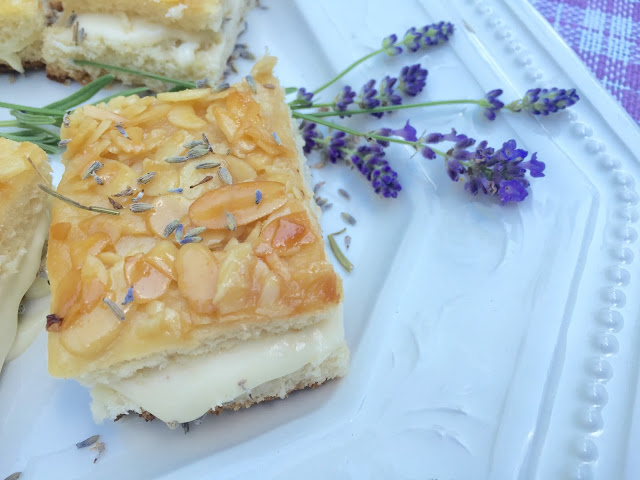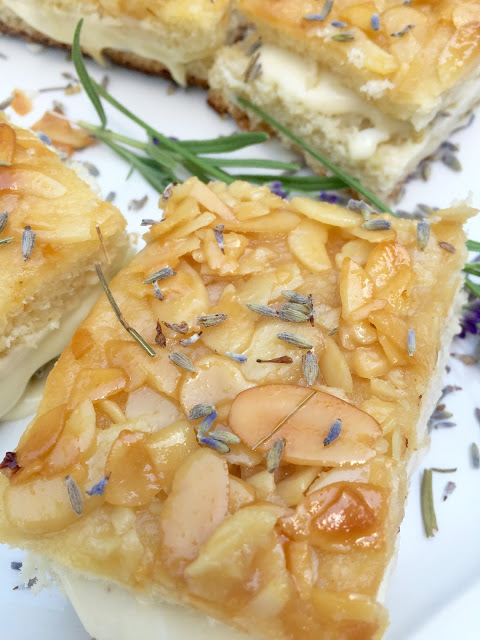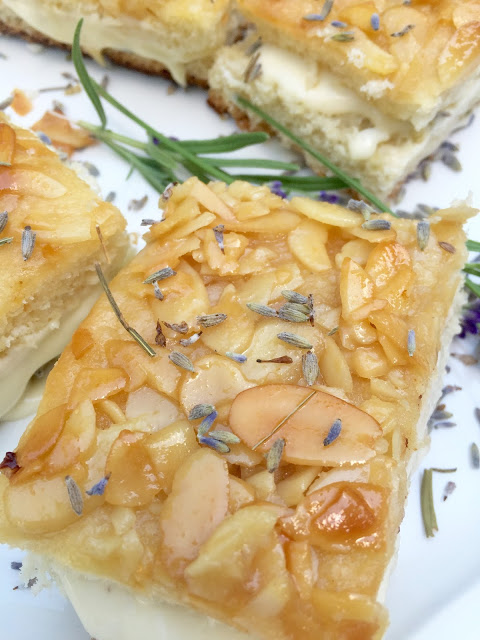So Summer is over. I’m pretending it’s not because I plan on posting some of the best desserts I made these past months.
For the first time in over 5 years of writing this blog, I fell off the posting wagon in a significant way. First, it was just because I’ve had the most amazing spring and summer filled with fantastic travel, great work, glittering events, new friends, and experiences. Then it was because I was too damn exhausted from living such a great life to write about it. I felt guilty (what blogger doesn’t when they neglect their “baby”?) but I needed a blog break, physically and mentally.
Yeah. First world problems.
Anyway, I will be posting about these adventures and recipes in the coming months starting today by sharing this Lavender Bee Sting Cake I made for about.com.
Baby steps people, baby steps.
One of the most beloved traditional cakes in Germany is called bee sting cake or Bienenstich in German.
The top layer has honey encrusted almond leaves. Baked as one layer as a sheet cake, it is then cut in half and traditionally stuffed with vanilla cream.
Not once I got ahold of it.
My flavor twist of substituting lavender pastry cream reinvents this classic in a big way. The combination of the crunchy honey, nutty top with the smooth flowery pastry cream is heavenly.
This recipe yields a significant amount so I recommend making it for a party or, alternatively, be sure you have lots of friends and family around to share it with.
Ingredients:
- 1/2 cup milk
- 3 teaspoons dry yeast
- 3 cups all-purpose flour
- 1 large egg
- Six tablespoons unsalted butter
- 1/2 cup plus
- 1 pinch salt
- 1 stick plus three tablespoons unsalted butter
- 3/4 cup white granulated sugar
- 2 tablespoons honey (I used lavender honey)
- 2 cups blanched almond leaves
- 5 tablespoons milk
- 1 tablespoon dried lavender plus more for garnish if desired
- 2 cups milk
- 3/4 cups white granulated sugar
- 1/3 cup flour
- 3 large egg yolks, slightly beaten.
- 1/2 cup heavy cream
- 1 tablespoons butter
Make the cake:
- Warm 1/2 cup of the milk.
- Add the yeast and dissolve.
- In a bowl, combine the flour, the egg, 6 tablespoons butter, 1/2 cup white granulated sugar and the pinch of salt.
- Add the yeasted milk and knead into a smooth dough.
- Cover the bowl with a dish towel and stow in a warm place for 45 minutes.
- Grease and flour a 12×14 inch baking sheet or jelly roll pan. Turn the dough out onto a floured work surface and knead once more.
- Transfer to the baking sheet and roll out the dough to fit the pan. Stow in a warm place for 45 minutes.
- In a saucepan over medium heat melt 1 stick plus 3 tablespoons butter, 3/4 cup white granulated sugar and the lavender honey together.
- Stir in the almond leaves.
- Stir in 5 tablespoons of milk. Remove the mixture from the heat and let cool.
- Preheat the oven to 400 degrees F.
- Brush the honey-almond mixture over the top of the dough.
- Place in the oven and bake for 15-20 minutes, until the top is golden brown. Remove from oven and let cool completely.
- Place the egg yolks in a small bowl. Set aside.
- Place the dried lavender, milk, sugar and flour in a saucepan over medium heat. Stir until the mixture starts to boil and has thickened.
- Strain the dried lavender pieces out of the mixture. Slowly pour the mixture into the bowl with the egg yolks, whisking constantly to temper them.
- Add the tempered egg yolks back into the saucepan and stir to combine.
- Stir in the butter.
- Transfer the mixture to a bowl, cover with plastic cling film, making sure the plastic touches the surface of the pastry cream.
- Chill for at least 2 hours.
- Whip the heavy cream and fold into the chilled lavender cream.
- Cut the cooled cake into quarters from the short side of the pan.
- Working with one rectangle at a time, slice the rectangle in half horizontally, remove the top portion of the cake, fill with the lavender pastry cream and replace the top cake layer.
- Once you have filled the four sections, cut the sections into smaller, serving size rectangles.
- If desired, sprinkle dried lavender over the top for garnish before serving.






